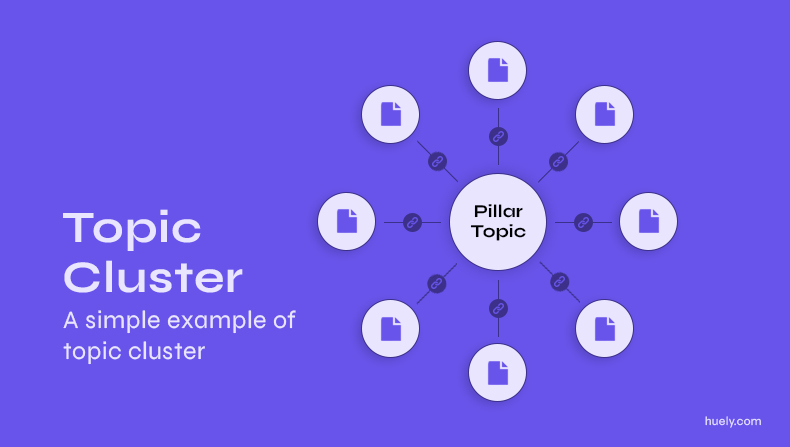Why you should create topic clusters
The days of simply making single content pieces won’t effectively catch the attention of search engines or users anymore. However, topic clusters offer a more optimized way to create content and showcase expertise in a specific subject.
You begin by creating a main piece of content that serves as a central hub for a topic. Then, you link related subtopics or supporting content back to that main piece. This action tells Google you possess extensive knowledge about the topic.
Topic clusters help search engines better understand your content and improve the user experience. Using topic clusters increases your chances of ranking higher on Google and adds weight to your E.E.A.T ranking signal.
Topic clusters vs. traditional keyword-based SEO strategies
As previously mentioned, traditional SEO typically targets single keywords, but topic clusters have a broader approach. Instead of concentrating on just one keyword, you plan for whole topics. However, topic clusters still rely on keyword research and page optimization techniques.
This algorithm change reflects users’ preference for more detailed content. As a result, Google now gives priority to broader content. Moreover, topic clusters provide more authoritative signals to Google and a better user experience.
Elements of a topic cluster
- Pillar content
Pillar content serves as the foundation of a topic cluster. This page should feature a broad topic that can support many additional sub-topics. It’s comprehensive and covers all essential aspects of that topic. Additionally, it facilitates easy navigation for readers to find the related sub-topics.
- Cluster content
The cluster content consists of all the subtopic pages surrounding the pillar page. These pages aim to delve deeper into the concepts expressed in the pillar page.
- Internal linking strategy
This is what brings it all together. Linking from your pillar page to each subtopic page, and vice versa, allows Google to understand the relationship between the content and identify it as an authoritative topic cluster.
A simple example of a topic cluster strategy
- Pillar content example
Begin by crafting a comprehensive article on a topic like, let’s say, “mental health of stay-at-home moms.” Due to its broad scope, this topic offers excellent potential for further elaboration.
PRO TIP: When choosing a pillar topic, ensure it is broad enough to have several sub-topics. Also, conduct keyword research to find keyword difficulty and traffic potential.
- Content cluster example
Now that you have your pillar page topic you will need to find the subtopics that make up you content cluster.
Some examples of subtopics for “mental health of stay-at-home moms”.
- What is depleted mother syndrome?
- Tips for managing stay-at-home mom depression
- Are children happier with stay at home moms?
- Daycare vs. stay at home mom
- Common causes of stress for mothers
PRO TIP: When choosing your sub-topic ideas use keyword research tools to find long-tail keywords to target.
- Internal linking strategy example
After creating and posting your pillar page, post the sub-topic pages. Be sure to link the pillar page to all subtopic pages and vice versa. Additionally, interlink the subtopic pages to strengthen the cluster.
Things to consider when building your topic cluster
Optimization: Optimize all pages within the cluster for search engines, including meta tags, meta descriptions, heading tags, content structure, etc.
User intent: Make sure your subtopics consistently align with user intent. Furthermore, always write your content specifically for the user.
Consistency: Maintain consistency in style, tone, and branding across all pages within the topic cluster.
Update and expand: Continuously update and expand the topic cluster with fresh content to remain relevant and authoritative in your niche.
Content Format: Tailor your content format (e.g., informational, transactional, navigational) to match the user’s intent and preferred method of consuming information.
Audit Your Existing Content
If you’ve been blogging for a while, you likely have a wealth of content. Instead of creating new topic clusters from scratch, leverage your existing content. Begin by auditing all your blog posts, listing them in a Google Sheet, and grouping related topics. Identify posts that can serve as pillar pages for these topics. If needed, add new pillar pages to your to-do list.
Organizing your content this way allows you to create multiple topic clusters without creating new content. Once your audit is complete and new pillar pages are created, start interlinking your clusters. Now, you have a more authoritative structure with a better user experience, which Google rewards.
Measuring and analyzing the impact of your topic clusters
- Organic search traffic
Utilize Google Analytics to monitor website traffic and see if there’s an increase in organic visits to pages within your topic clusters.
With GA4, you can even create custom reports by filtering out specific page paths. Use this to put your clusters into separate reports.
- Keyword ranking
Track keyword rankings to assess whether your topic clusters improve search engine visibility for targeted keywords.
- Engagement Metrics
Utilize Google Analytics to look at metrics like “average engagement time.” With an effective topic cluster, you should see these metrics rise. If you don’t see this metric improve for your cluster content, it might be worth improving.
- Internal link click-through rate (CTR)
Utilize Google Analytics to measure internal click-through rate. You want to discover how effectively your pillar page drives traffic to the sub-topic pages and vice versa.








